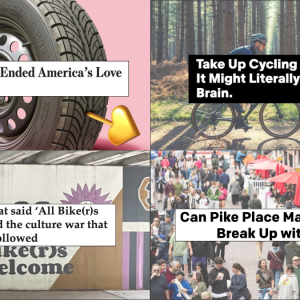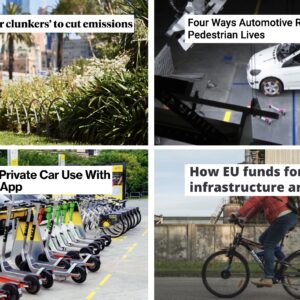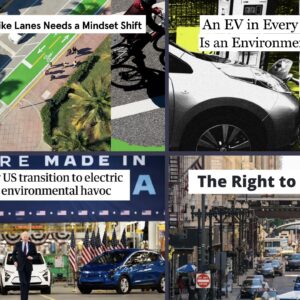
It’s the Monday Roundup… On Tuesday!
Here are the stories that caught our eyes in the past week.
Bike theft drop: The latest data from the UK says bike theft has dropped 25 percent in five years. While most theft goes unreported, this is still a very encouraging sign.
A golden idea: The Netherlands wouldn’t be at home without their bikes at the Olympics so they brought a fleet with them to Rio.
Excuse our mess: Watch the lengths this Copenhagen work crew goes to avoid inconveniencing — err, umm getting dirty — people on bicycles.
They say it but won’t — and shouldn’t — do it: As per usual, the two presidential candidates say they want to spend billions on new highways and bridges. Not only would that lead to outdated projects, a writer with Bloomberg says that money would be better spent locally.
Speed kills, even on bikes: Been expecting this type of research: The higher speeds of e-bikes are likely to cause more crashes. Duh. It’s not about the type of bike though, it’s just about speed. Slow down if you want to live.
Advertisement
Shit hitting fan: Fires, record heat, epic floods; this climate change stuff isn’t a theory or a conspiracy. Rolling Stone lays out the case on why we should all be worried and why we should all make better choices to slow it down.
Amsterdam problems: Very illuminating article about the new Bike Mayor of Amsterdam who says too many (rude) people on bikes might make it a less safe and therefore attractive option.
Transit fashion: A designer who makes clothes inspired by subway seat fabric. How was this not started in Portland?!
Get-rich-quick scheme for cities: More evidence from New York City that protected bike lanes are good for business. Can someone send this link to the Portland Business Alliance and CC Commissioner Novick and Mayor Hales? Thanks.
Countdown to launch: Audi says putting red light countdown timers in their 2017 cars could make for “more relaxed” driving. Either that, or wanna-be drag racers will use it to beat the competition.
Do you keep up with the latest news and love the Monday Roundup? We’re looking for a Monday Roundup editor. It could be you! Please get in touch if interested.
— Jonathan Maus, (503) 706-8804 – jonathan@bikeportland.org
Our work is supported by subscribers. Please become one today. You can also make a one-time donation here.






Thanks for reading.
BikePortland has served this community with independent community journalism since 2005. We rely on subscriptions from readers like you to survive. Your financial support is vital in keeping this valuable resource alive and well.
Please subscribe today to strengthen and expand our work.
I’ve pondered E-bike speeds for awhile. As a regular rider, for recreation and commuting, I’ve accepted e-bikes as part of our shared bikeway system. I’ve thought that one aspect of them is that the higher speeds of e-bikes can pose crash risks in high bike traffic situations like the Hawthorne Bridge.
High bike traffic situations can have bike riders passing other bike riders in close quarters. Before e-bikes, the faster riders were typically relatively experienced riders, which was how many got to be faster riders. With that relative experience, many faster riders had some commensurate bike handling skill that made tight-quarter passing reasonably safe. (This is not addressing inconsiderate riding…)
But e-bikes change this. Relatively new riders now have the speed to pass, maybe without corresponding bike handling skills. So I think newer e-bike riders will need to reconcile their close-quarter riding with their new-found bike speed.
I agree. Speed + inexperience = : (
Yes–say, 20mph and up is a speed range where you can do yourself serious damage falling off of a bike. With a non-motorised bike, it will take you long enough to develop the fitness for that speed so that whether you intend to or not you will develop some significant bike handling skill and traffic judgement. With any motor assisted bike, you’ve got the speed before you build the skills. That’s where trouble is!
It’s an issue the public (trail users) have brought to our BPAC for a while, as even experienced cyclists have complained about being passed unsafely. Our trails have some sections with marked speed limits (15 MPH) but not many. Our city chose to wait until California actually passed legislation regulating e-bikes, primarily because the definition of them needed to be more definitive. The debate still goes on, with some people going so far as to want to ban (from trails) the class that can achieve 25 MPH.
I’ve been saying this for a while, and am glad it is gaining traction.
You can’t put >99th percentile power in everyone’s hands if there is no correlation with experience, at least not in the bike lane—that’s the sort of thing you find one lane over…
You’re painting a picture of e-biker noobs riding around full throttle everywhere, unable to skillfully handle their machine, and that’s unfair. Although they may not get the culture or etiquette yet, I have found e-bikers to be cautious riders who do not pose a significant risk to other road users. Does anyone know if an e-bike has shown up on a Portland Police crash report?
Crash reports of collisions, aren’t a good indicator of inconsiderate or dangerous operation of vehicles.
Potential problem of e-bikes, as a number of people commenting to this discussion have noted, is that their riders don’t have to exert any significant physical effort to have their bikes go speeds that on a pedaled bike, are attained only with quite a lot of effort expended.
In simple terms, it stands to reason that people riding pedaled bikes, are likely to be less inclined to ride their bikes a consistent 20 mph(legal top speed limit for e-bikes.) regardless of climb rate, than will people riding e-bikes. This may not be much noticeable, until gradually, people find e-bikes in use, common where they ride their pedaled bikes, walk or run. It’s kind of a ‘wait and see’ thing, I think, as far as incidents of obnoxious and inconsiderate use of e-bikes is concerned.
In my experience, e-bikers tend to be among the politest riders. Currently, the typical e-bike in PDX is an upright bike that is clearly used to carry groceries, kids, and other loads. In contrast, “experienced and competent” cyclists on their year-round drop-bar bikes tend to be among the fastest riders and often visibly express impatience when they encounter slower riders. It’s almost as if the “experienced and competent” demographic is resistant to positive change — to increased cycling mode share.
For me, the issue isn’t the speed nor is it the fact that most e-bike riders have the speed without developing the skills that historically comes with being able to ride above 20 mph (which really isn’t that fast; even old folks like me can manage that). It’s the fact that we have been building our bike infrastructure as though no one rides over 10 mph and also as though we will never attract very many people to ride. We build for failure, then when there’s a hint of success, there are conflicts.
Here lies the great promise of e-bikes, imo. By allowing large percentages of the population to ride along at reasonable speeds, we can get ever larger numbers of people out of cars. However, this can only work if our traffic engineers/planners begin to understand the space necessary to make this work. Time to do away with ten, or even twelve, foot wide bike paths and five foot bike lanes. Those just aren’t going to cut it. Time for traffic engineers to behave like actual engineers dealing with the properties of this growing vehicle segment.
I’m not so concerned about the danger some e-bike riders may personally expose themselves to by exceeding their ability to safely ride their bikes…but am concerned about the danger some e-bike riders may pose to pedal powered bikes ridden by people in bike lanes and on MUP’s.
When figuring that plenty of people at one time or another when out for a ride, won’t be moving on their pedaled bikes, faster than 10mph…an e-bike cruising by them at 20mph, is fast.
In general, because of their electric motor power source, the potential for e-bike use to significantly diminish the quality of riding experience available on bike lanes and MUP’s for people walking and biking, is I think, something to be wary of. A lot of e-bike riders chomping the bit, speeding along at 20mph around people walking by themselves, with kids, pets, people pedaling bikes, doesn’t sound so wonderful.
It’s a result of people not understanding the basic rule of driving (it applies to bicycling as well): Don’t go faster than the conditions warrant. I am a “faster rider” but I know well enough to just take it easy in heavy traffic, because for all the effort it takes to get in front of everyone else, I’ll just end up sitting at the same red lights anyway.
People need to get over their entitled sense of needing to be first in line, especially in traffic. Accidents can cause physical injury, whether on a bike or in a motorized vehicle.
This is all why I’ve been saying e-bikes are a great thing, but the electric assist should be limited to 15mph rather than 20mph.
The fears of ebikers aren’t unwarranted, yet it’s quite comical reading these comments!
> it’s quite comical reading these comments!
Yea, it is. Change bike to pedestrian, and ebike to bike. How would commenters here respond to such statements?
>I’ve thought that one aspect of them is that the higher speeds of e-bikes can pose crash risks in high bike traffic situations like the Hawthorne Bridge.
How many crashes on the bridge have involved ebikes? How many involving human powered bikes?
>Before e-bikes, the faster riders were typically relatively experienced riders
Experience on a bike – or hours spent in a gym – doesn’t make someone courteous, considerate, or safe. It doesn’t mean they’ll moderate their speeds. Many don’t.
Ugh! I like to leave pedestrians I wide berth on the bridge, and every now and again someone rides up behind me and tries to squeeze by, making my wide berth a close pass. If this sounds like you, cut it out!
I’ve taken to looking over my shoulder (should really get a mirror on both sides…) before passing anyone with a wide berth for that very reason.
Sometimes people are just the worst, aren’t they…
People do this to me, too. It’s a small sidewalk. Perhaps it’s time to make the outside car lanes bike-only?
Buses don’t fit on the inside lanes.
Then make the center lanes bike only and the outer lanes bus only.
I’m not sure how that would work, but I would consider making the outer lane bus and bike. I don’t know how much more bike traffic the bridge can safely handle.
Shared bus/bike lanes are generally a bad idea as they combine the largest vehicles with the most vulnerable. Imagine the bus driver having to merge into a stream of cyclists.
Btw, I have seen a bus use the center lane, so my guess is that the issue is that it’s not wide enough for two buses to pass each other. Maybe the solution is a two-way cycle path on one side, and using the center lanes (as a single lane) and other outer lane for buses. After banning cars from the bridge, there would be plenty of room on the east side viaduct for separated cycling facilities leading to Hawthorne Blvd.
Or we could build another bridge for active transport…
Or just put streetcars back on the Hawthorne instead of buses and cars.
That would be a great enhancement for the cycling environment!
Not everything is about bikes.
Especially not streetcars.
I think there’s plenty of room in the center for 2 buses, just not much margin for error. Streetcars are a way to solve that for lots of money (or debt) but we could just time the buses and the drivers could always slow down if they got off on the timing. We could probably add laser guidance or build a chute of rubber rollers and still have money left for a decade of free rides on the whole network.
The MLK and SE water ramps would complicate the design. Also, eastbound peak hour counts on the bridge are in the neighborhood of 2k vehicles. The number of transit riders on buses might outnumber the number of cyclists, if not they aren’t far off. A plan to accommodate cyclists first, no matter the impact on greater number of other road users, might not be very popular.
The solution is far simpler if you ban cars on the Hawthorne Bridge and viaduct and only allow cycling, walking, and public transport.
Is that legal regarding wha Audi/VW plans to do?
““If you’ve got 45 seconds, you can take care of the kid in the back seat,””
that’s the problem, encouraging more distraction…
the time you’re sitting at a red light is when you’re supposed to be paying attention to things around you so that you know you’re good to go when it turns green…
you don’t just stomp the skinny pedal as soon as the light turns green without knowing the environment around you is safe for such an action…
if the kid needs attention then pull over out of traffic and take care of them…
I know that this makes me a bad person (stereotyping drivers) but may well keep me alive as well. Heck, I’ll just say it–Audis seem to attract the most viciously aggressive drivers on the road the last few years. Don’t care if they have a “share the road” plate, rack on the roof, and OBRA sticker on the bumper, Audi has marketed to hormonally overcharged schlongolas and their customers’ behavior on the road makes it very obvious.
Dude, you just described my S4 to a ‘T’… 😉
https://www.youtube.com/watch?v=WJfvYkZLp84
The slogan at the end should be:
“Audi — Drive like an Aushole”
Here in Silicon Valley most luxury car drivers drive like aggressive A-holes, but it’s been the minivan drivers that most consistently put me at most risk.
BTW, the Audi is definitely fun to drive hard (yes, on the track), but I’d never own one again. I bought an Acura for reliability, and shortly after they came out with this wonderful advertising campaign:
https://www.youtube.com/watch?v=nBQI0XFU2B8
“Aggression in it’s most elegant form”… clearly they were targeting Audi owners! 😉
I’ll stop stereotyping drivers as soon as car companies stop selling their products as “lifestyle” items.
Seems fair. Especially since bike companies market their products as ‘lifestyle” items, and we know how cyclists are stereotyped…
I guarantee their lawyers will indemnify them because they’re just providing the information, and it’s the driver who would break the law if proceeding on a red. (I think the term I heard in England was “amber gambling”, though not exactly sure how it’s applied).
“It’s a huge benefit for the infrastructure and vehicles to talk to each other,” time to start lobbying for speed governors in all infrastructure-communicating vehicles. Though it might backfire if drivers get used to holding the go pedal all the way down and they come to a place with no speed limit transmitter… wait, that’s how a lot of people drive now.
That Rolling Stone article is a year old.
Which makes our cultural cognitive dissonance when it comes to climate change even more idiotic.
“The Netherlands is known more for cycling than athletics” please don’t tell their Olympians (7th in the medal count) or soccer players (2nd in 2010 world cup, 3rd in 2014 world cup).. though on Bike Portland, I am sure that is true!
The Dutch do have a great national football team.
Well……4 Olympic road cycling events, 3 medals to the Netherlands including silver in the mens’ time trial for a rider (Tom Dumolin) whose broken wrist was still healing.
I’m still working out the bit that said “their first ever Gold medal”- considering they already have six in this games…
my mistake GlenK. Sorry for confusion and sloppiness. Cleaned that one up.
The link to the transit fashion piece isn’t working; here’s the actual article: http://www.thisiscolossal.com/2016/08/outfits-sourced-from-german-transportation-fabric/
since bike trips already make up ~68% of trips in central amsterdam the obvious solution is to ban or further limit cars. without the bottlenecks of under-used car lanes and car-centric signals this “rudeness” would largely disappear.
Why do her statements remind me of Yogi Berra, he of “Nobody goes there anymore. It’s too crowded” fame?
Soren is absolutely correct. When a locale succeeds in getting people out of cars, it’s time to acknowledge it and stop giving the cars most of the road space.
Was that Yogi Berra or Groucho Marx?
The reason the bike lane would be closed in the US (Excuse Our Mess) is that overhead lifting can be hazardous, not that cyclists are treated “like dirt”. One could argue that routing people under such an operation is more disrespectful and dangerous than routing them around.
Of course, in most US jurisdictions, they’d just close the bike lane and have that be the end of it, rather than reroute bike traffic, but that’s a secondary point.
The last I checked, there were at least four presidential candidates, not two.
So many good choices!
Almost like a Baskin-Robbins…
I’ll take a double scoop of hate, please, and a dish of corruption for my friend here.
The link to the Bloomberg article goes somewhere else. Correction, please! In my book, bike / ped trails and related infrastructure should be part of rebuilding our National transit network. Building or expanding freeways cannot be considered to be the only solution. Besides, think of the jobs created by building the national bike route network, not to mention those created by trailside cafes, overnight stay facilities, grocery stores, etc.
The e-bike story is interesting.
The dramatically higher level of problems is concerning, but I have to wonder how a “critical” event is defined. One every 16.7 km for e-bikes and one every 24.5 km for regular bikes sounds absolutely ridiculous. I would hope one could ride many thousands of miles without being in one.
The other thing that was interesting is that these things were only averaging 2.5 mph faster than non powered bikes. That’s hardly anything so it seems reasonable to infer that such a drastic difference is better explained by a disparity in skills/judgment than speed — especially since a lot of non-powered riders move faster than e-bikes on most roads to begin with.
2.5mph faster than 8, or is it 12? The “30% more incidents” makes me think 8 was the human-power average, since 10.5 / 8 = 1.3.
I wonder what the average power was. 200W isn’t going to add much to an uphill, stops mattering at 20mph, and you generally just get to the red light sooner unless your traffic signals engineers ride e-bikes to work (ahem.) Also note, they took more frequent trips so maybe not working as hard during that dinner takeout errand — i.e. motor only adding 50W to the total power because legs are taking a break.
I remember an article (I think from the roundup in the past year) about the safest speed to ride? It also depends on the street design and rider behavior. Hugging the curb at 20mph is like riding at 10mph on the sidewalk. Every cross street or driveway has someone in an SUV talking on the phone and rolling through the stop sign. Most bike lanes are not appropriately wide and/or lack sufficient sight/clear distances. Ask a PBOT engineer about the design speed for a bike facility. hahahahyundai.
Too fast for conditions is one thing, but most drivers simply cannot judge a bike’s speed or even “see” a person on a bike. With no light, you vanish. With one light, you’re just a dot. Sometimes it helps if you clown-pedal. Moving 15-20mph uphill confuses people and you can easily power your way into a right hook or other conflict if you don’t think ahead and plan to deal with some oblivious/illegal driving (e-bike cops would help.) You need to pay attention and be visible at a level appropriate to your total power, and maybe a bit more to make up for being under-estimated. Turbospoke?
How many comments have there been on this site when the weather gets nice in the spring about the problems from inexperienced new riders?
A study based on 12 inexperienced ebike riders who rode an average of 125 km over two weeks doesn’t mean much.
That SHF piece from last years rolling stone is way outdated already. . . and not in a good way.
I watched deer herds crowding and jostling around dessicating springs last night at 6000 ft in Marble mountains. Their level of aggression and territorial behavior was stunning.
It reminded me a lot of homeless humans clustered and occupying pretty much everywhere south of Salem not fenced off or guarded by protectors of private property..
The most stunning though is the ACCELERATION of warming and its obvious effects.
Consider yourselves lucky north of the 45 degree line. . . .FOR NOW.
The orange death of conifers extended up to around Cottage Grove as of two weeks ago. Ive watched this spread north from Fresno since around 2001.
If a tree starts to turn orange, its terminal. Unfortunately succession species can’t catch up. There went your shade. Blamed on a damn beetle!
Park the car or this continues.
For now bearded boys boldly bomb their way towards BC on the PCT seemingly in a hurry to get while the gettins good.
Most of them being far too in a hurry, too young to remember the same baselines we do and obviously in it for the facebook cred of completing the epic point A to point B
Just back from 3 weeks in the Netherlands. Love that the Dutch brought their bikes with them to Rio! The imagery of these huge (6’5″), immaculately dressed Dutch guys passing me easily in the bike lanes is one I won’t soon forget. Their legs would look ridiculous on our low short bikes but on the upright Omafiets it all works without creasing one’s trousers for the office. Natuurlijk!
I wouldn’t summarize the Bicycling Mayor as saying the growing concern is “rude people”. That’s a very American way of thinking about it. Its more a general angst about changes in populations and frankly, core values. The entire system in Amsterdam is based on massive amounts of trust in your fellow man/woman to be competent, to know what the rules are and more than anything – to follow the rules. The margins are a matter of 2-4 inches sometimes, less than half a foot separates me from the speeding moped. EVERYONE needs to be on the same page so that it is all predictable. Any hesitation, any uncertainty will cause the entire transportation flow to come to a screeching halt. The huge growth in scooters from last time we were there is a major factor.
It is completely fascinating to me the way it all works and some of their facilities and I would love to get into an in depth discussion about it.
I believe scooters will soon be banned from cyclepaths in Amsterdam and a few other cities.